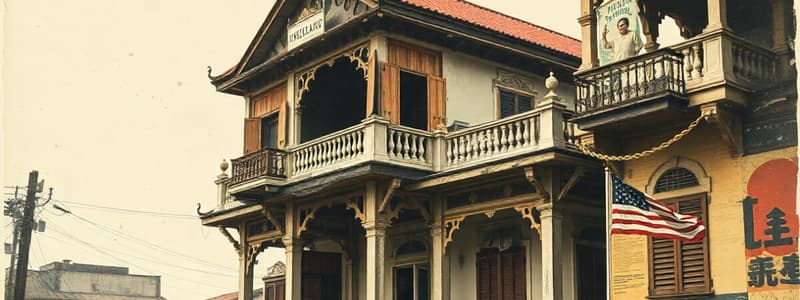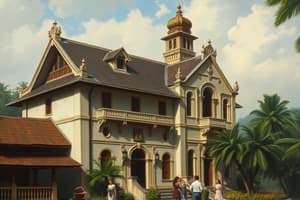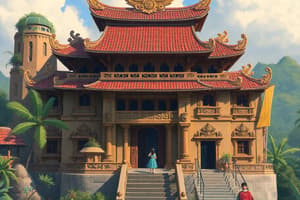Podcast
Questions and Answers
Which of the following BEST reflects the core of Mañosa's philosophy of Filipino architecture?
Which of the following BEST reflects the core of Mañosa's philosophy of Filipino architecture?
- To prioritize sustainability by incorporating indigenous materials and emphasizing natural ventilation.
- To blend modern technology seamlessly with ancient Filipino building techniques for maximum efficiency.
- To reclaim and modernize traditional Filipino building practices, preserving ancestral wisdom for future generations.
- To create unique and expressive structures that embody the Filipino spirit and meet present-day needs. (correct)
What significant event in Mañosa's life marked the beginning of his quest to define Filipino architecture?
What significant event in Mañosa's life marked the beginning of his quest to define Filipino architecture?
- His realization at age 30 that Filipino architecture should capture the Filipino psyche.
- His acceptance of his father's wishes to pursue a career in architecture instead of music.
- His early experiences with both classical and modernist architecture, which led him to appreciate the beauty of vernacular styles. (correct)
- His decision to dedicate his practice to establishing a distinct Filipino architectural style at age 21.
What does Mañosa emphasize as the key elements of his architectural style?
What does Mañosa emphasize as the key elements of his architectural style?
- A harmonious blend of functionality, aesthetics, and environmental sustainability.
- The creation of structures that evoke a sense of nostalgia while adapting to modern needs.
- The integration of cutting-edge technology and traditional craftmanship.
- The use of indigenous materials, a sensitive approach to the landscape, and spaces that meet the needs of Filipinos. (correct)
What is Mañosa's central argument about the importance of using indigenous materials in Filipino architecture?
What is Mañosa's central argument about the importance of using indigenous materials in Filipino architecture?
What is implied by Mañosa's assertion that “One eye must see architecture, the other must feel”?
What is implied by Mañosa's assertion that “One eye must see architecture, the other must feel”?
What is the main implication of Mañosa’s statement, “Let Filipinos of all classes responsibly reap the bounty of our environment.”?
What is the main implication of Mañosa’s statement, “Let Filipinos of all classes responsibly reap the bounty of our environment.”?
What is the central message conveyed by Mañosa's statement, “Let our countrymen reach their potential through constant uplifting of their communities developed in harmony with nature.”?
What is the central message conveyed by Mañosa's statement, “Let our countrymen reach their potential through constant uplifting of their communities developed in harmony with nature.”?
Which of these statements BEST encapsulates Mañosa’s ultimate ambition as an architect and a Filipino?
Which of these statements BEST encapsulates Mañosa’s ultimate ambition as an architect and a Filipino?
What must architecture be true to in order to be valid and meaningful?
What must architecture be true to in order to be valid and meaningful?
What does Bobby Mañosa suggest about the relationship between old and new in architecture?
What does Bobby Mañosa suggest about the relationship between old and new in architecture?
Which indigenous house is considered foundational to the evolution of Filipino architecture?
Which indigenous house is considered foundational to the evolution of Filipino architecture?
What challenge did the evolution of the bahay na bato face?
What challenge did the evolution of the bahay na bato face?
What climatic conditions does the Philippines face that impact architectural designs?
What climatic conditions does the Philippines face that impact architectural designs?
Flashcards
What is the main principle of Filipino architecture, according to Bobby Mañosa?
What is the main principle of Filipino architecture, according to Bobby Mañosa?
Bobby Mañosa believes architecture must be authentic and reflect the culture of the people, land, and history. It should be relevant to the people and time.
Why is the bahay kubo important for Filipino architecture?
Why is the bahay kubo important for Filipino architecture?
Mañosa emphasized the importance of drawing inspiration from traditional Filipino architecture, particularly the bahay kubo. He believed that understanding and building upon the bahay kubo was crucial for developing a unique contemporary Filipino architectural style.
What qualities of the bahay kubo represent the essence of Filipino architecture?
What qualities of the bahay kubo represent the essence of Filipino architecture?
The bahay kubo's simplicity and functional design are characteristic of Filipino architecture. Its basic structure and essential elements embody the true spirit of Filipino architectural design.
How does the transition from the bahay kubo to the bahay na bato demonstrate the evolution of Filipino architecture?
How does the transition from the bahay kubo to the bahay na bato demonstrate the evolution of Filipino architecture?
Signup and view all the flashcards
What are important factors in determining the design of Filipino architecture?
What are important factors in determining the design of Filipino architecture?
Signup and view all the flashcards
Filipino Architecture: Capturing the Filipino Psyche
Filipino Architecture: Capturing the Filipino Psyche
Signup and view all the flashcards
Traditional and Modern: Blending Filipino Roots with Contemporary Design
Traditional and Modern: Blending Filipino Roots with Contemporary Design
Signup and view all the flashcards
The Beauty of Indigenous Materials
The Beauty of Indigenous Materials
Signup and view all the flashcards
Blending with the Landscape
Blending with the Landscape
Signup and view all the flashcards
Feeling Filipino Architecture
Feeling Filipino Architecture
Signup and view all the flashcards
Mañosa's Mission: Improving the World Through Architecture
Mañosa's Mission: Improving the World Through Architecture
Signup and view all the flashcards
Architecture as Art
Architecture as Art
Signup and view all the flashcards
Uplifting the Filipino Spirit
Uplifting the Filipino Spirit
Signup and view all the flashcards
Study Notes
Filipino Architecture: A Philosophical Approach
- Filipino architecture, to be meaningful, must reflect the land and its people.
- Filipino architecture is not just about imitating the past; it's about evolving from the past to the future.
- Filipino architecture must start with the bahay kubo, an indigenous house, and use it as a foundation to build upon.
- Filipino architecture evolved from the simple bahay kubo to the bahay na bato, reflecting changing lifestyles.
- Climate, earthquakes, and the landscape are critical influences in Filipino architecture.
- An architect must consider Filipino culture when designing.
- Filipino architecture seeks to capture the Filipino psyche and uplift the Filipino spirit through distinctive structures.
- Contemporary Filipino architecture should be rooted in culture, be organic to the landscape, and use indigenous materials.
Francisco Mañosa's Journey
- Francisco Mañosa's philosophy emphasizes the importance of indigenous materials.
- Mañosa's work is an artistic interpretation of Filipino design principles, integrating landscape, indigenous materials & meeting the needs of Filipino people.
- His style involves a significant blend of intuition, play, and improvisation.
- His philosophy is to interpret the Filipino spirit for the modern age.
- Mañosa believes Filipino architecture should blend with the indigenous environment.
- His work attempts to demonstrate the inherent beauty of Filipino vernacular architecture.
- The bahay kubo and bahay na bato are examples of resilient structures suited to the Filipino landscape and lifestyle.
Mañosa's Beliefs and Influences
- Mañosa's journey started with a deep fascination to understand Filipino culture, and he embraced both classical and modernist architecture.
- He sought to create contemporary architecture rooted in Filipino vernacular forms.
- His personal journey influenced his architectural philosophy, particularly his understanding of the Filipino identity.
- Mañosa's work seeks to address the specific needs of Filipinos for today.
- Mañosa values using Filipino-specific materials, arguing they are an essential and beautiful component.
- His work values using Filipino-specific materials, arguing they are an essential and beautiful component.
- His work is not only about form, but about the cultural and emotional needs.
- Mañosa's work has been influential in shaping Filipino architecture and landscape.
Mañosa's Mission
- Mañosa aims to create Filipino architecture that captures the Filipino spirit, is contextually sensitive, and meets contemporary needs.
- He believes that Filipinos should be proud of their culture and responsible for utilizing their resources for sustainable projects.
- Mañosa actively seeks to uplift his country for future generations.
- Mañosa expresses his happiness for the current recognition of Filipino architecture globally.
Studying That Suits You
Use AI to generate personalized quizzes and flashcards to suit your learning preferences.




